
Checking your SEO performances and Google rankings are crucial for every serious company, website or a blogger who’s focusing on the organic traffic.
But, checking your true rankings isn’t as easy as the vast majority of people are doing.
Most beginners manually check rankings for their articles by typing keywords in Google.
This is okay, but the problem with this method is that it doesn’t always show you the accurate results.
This does not give you a proper idea of where your articles stand for the target keyword. This is happening due to a lot of different factors (such as cookies for example), and sometimes even going in an incognito mode inside your Chrome won’t show you the right results.
So, if you want to identify the exact rankings of your WordPress articles on Google, make sure to read this article and follow the steps inside it.
At the end of this article, you will learn how to see the exact rankings of your articles.
Post Quick Links
Jump straight to the section of the post you want to read:
WHY SHOULD YOU CHECK THE RANKINGS OF YOUR WORDPRESS BLOG POSTS?
The first step towards ranking on Google is making your WordPress blog posts SEO-friendly. If you don’t know how to do that, make sure to check it out.
Making your articles SEO-friendly will make you sure that your blog is going to rank for the keywords that have some search volume and hence - you will get organic traffic.
If you don’t optimise your article for SEO, you can easily end up ranking for the keywords no one is typing into Google.
Most beginners simply search on Google to see if their posts are appearing for those keywords. Even then, they usually only check the first page or probably the second or third page at best.
The issue is that sometimes, your article might be ranking below the second page, or in the worst case - perhaps you’re not ranking for that keyword at all.
Another reason why manually checking Google gives false results is because of your cookies. If you visited your blog post too often, Google might show it for you on the top of the page because you already made an interest for it. But the reality might seem different.
If you rely on manually checking your keyword rankings, then you are missing out useful information that you can use to improve your SEO rankings and increase organic traffic. Thus - this article will be really important for you.
That being said, let’s take a look at how to properly check keyword rankings for your WordPress blog posts.
USE PROXIES FOR CHECKING GOOGLE RESULTS
If you rely on the manual Google checking, then make sure to use proxies.
As we already mentioned, manually checking Google will give you false data. Especially because of the cookies.
On the other hand, Google has a tendency to show different results based on your country.
That being said, keywords that are ranking first on Google in the USA might not rank first in France, perhaps they’re second or third - but not the first.
Because of this, it’s crucial to use proxies for checking your SEO rankings.
You can use proxies from USA, Germany, France, or any other country you want.
This is definitely gonna help you find better results and more accurate data.
Finding your WordPress blog post rankings with proxies is extremely easy.
Everything you have to do is to make an account on LimeProxies, find the proxy you want to use, go to Google, type your potential keyword, and check whether you’re or not ranking for that keyword.
It’s simple as that!
Now when we know how to use proxies for checking Google rankings, let’s see some other great tools for doing that!
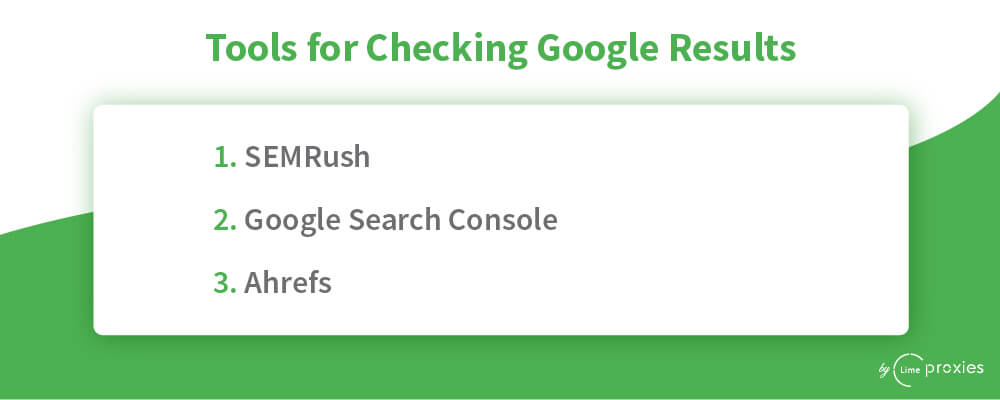
1. SEMRUSH

SEMRush is definitely one of the best Keyword research and SEO tools on the marketplace. It’s made of a bunch of different SEO tools, combining together into one comprehensive SEO suite that will satisfy all of your needs - not just checking your keyword rankings.
It also has a powerful organic research tool that can show you different keyword rankings both for your and other domains as well.
Finding your WordPress keyword rankings inside SEMrush is super easy.
Everything you need to do is to enter your URL, and SEMrush will do the rest. You’ll be able to see a huge list of all organic rankings and traffic you have.
Not to mention that you can also export your keyword rankings into a .csv sheet so you can conduct a more detailed analysis of them.
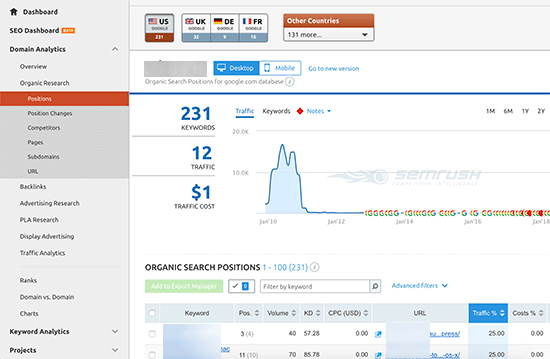
But, the best part about SEMRush is not just finding your organic rankings.
With SEMRush, you can also constantly monitor your WordPress keyword rankings and be aware of everything that’s going on with your Google presence.
SEMrush is also great for conducting keyword research. Simply put your desired keywords inside SEMrush, and it will show you the list of other relevant keywords with their search volume and difficulty of ranking there.
This is great for making your content plan and making sure that all of your future WordPress blog posts will see the daylight on Google.
SEMRush is suitable for mid-size companies that are investing their money into SEO. Its pricing starts at $99/mo and goes up to $399/mo.
2. GOOGLE SEARCH CONSOLE
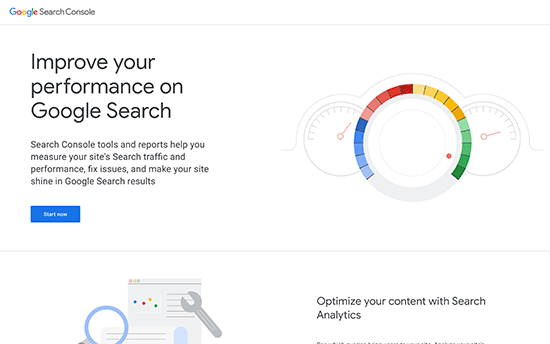
Google Search Console (formerly Webmasters Tools) is a set of tools offered by Google to help website owners improve their website for search.
It’s a free tool designed for everyone who wants to rank better. Although it doesn’t offer some amazing, in-depth and great features like SEMRush, Ahrefs and other are, Google Search Console is great for identifying certain errors on your blog posts that are stopping your website from rankings as well as for finding organic keywords where you’re already ranking.
With Google Search Console, you can see your website’s performance in search results, impressions, click-through rate, position, and much more than that. You can also force Google to crawl your website and index the unindexed pages by submitting the XML file of your sitemap.
To view your keyword positions, click on the Performance report and then click on the average position score.
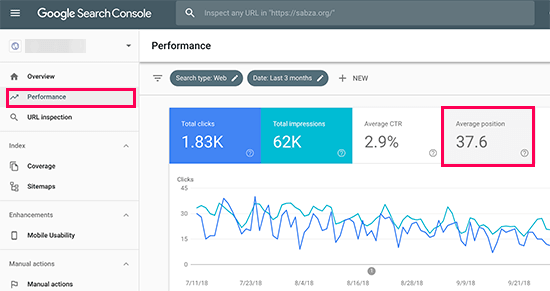
Search Console will now load your reports with an average position column included. Now - you’ll need to scroll down a little bit in order to see the full list of organic keywords where you’re already ranking.
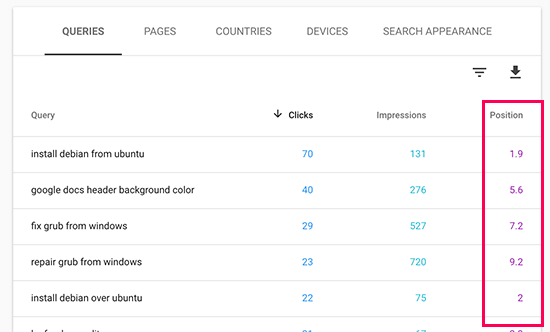
Right after each keyword, you will see how many clicks you get from it, the number of impressions and a position in search results.
You can easily sort results by the number of clicks, impressions and position columns. By sorting using the keyword position column, you will be able to see your top ranking keywords.
As you scroll down, you will be able to see keywords where your site appears deeper in search results.
You can also export this data into a .csv file and open it with your favourite spreadsheet tool and play with data.
3. AHREFS

Ahrefs is another popular SEO tool among professional marketers and SEO guys. It comes with an easy to use interface and great robust and in-depth features.
It’s known as one of the best SEO tools on the market because it offers you a lot of possibilities and opportunities.
Everything you need to do is to enter your website domain in the search, and Ahrefs will automatically create a nice-design page for you with all the graphs and statistics you need to understand your WordPress blog’s performance in Google.
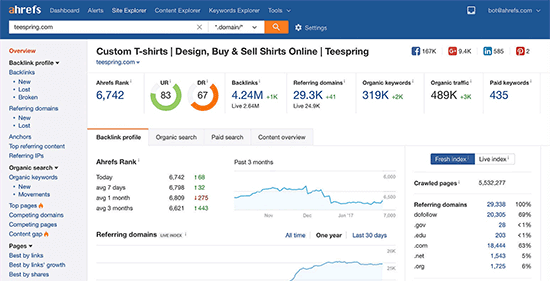
There, you will find all your keyword rankings under the organic keywords report.
Right after each keyword, you’ll be able to see its search volume, keyword ranking, keyword search volume, traffic, and more.

Ahrefs is also an amazing tool for backlink building campaigns. It offers you a lot of different features that will help you to find broken links on other websites, identify the possible backlink building opportunities and research other website’s content so you can get great ideas.
But, all of these features are coming with a little bit bigger price. Ahref’s most basic plan costs $99/mo, while the most advanced plan costs $999/mo.
HOW TO USE KEYWORD RANKINGS TO GET MORE TRAFFIC ON YOUR WEBSITE
Now that you have learned how to check keyword rankings for your WordPress site, let’s talk about how can you improve your website rankings.
Understanding your keyword rankings is crucial, but what are you going to do afterwards is probably even more important.
Here’s how Ugljesa Djuric - Organic User Acquisition Specialist at lempod - Marketplace of LinkedIn Engagement Pods, is using keyword rankings to drive even bigger traffic to their website:
“Everything starts with in-depth SEO research and audit. Once we identify the potential keywords, we’re writing an article for that particular keyword. We’re making sure that each of our articles mentions our focused keyword (the most important one), at least 15-30 times. This gives Google a clear signal that we’re writing an article that’s suitable for that keyword.
Once we publish the article, we’re usually able to rank pretty fast on the 10th - 20th position of Google. Now, in order to rank even higher, we’re building backlinks to our articles where the anchor text is our focused keyword.
This is helping us to give a clear sign to Google that our article is optimised and valuable to its audience.
On this way, Google climbs our articles even higher in search results and we’re able to get a tremendous amount of traffic on our websites.”
Now when we know how lempod is doing it, let’s see a quick step-by-step guide on how can you do it as well.
ANALYZING WHICH KEYWORDS NEED IMPROVEMENT
It’s important to note that not all keywords are created equal. Some keywords have bigger search volume, some of them are easier to rank for, while some of them are not worth at all.
For example, ranking #5 on a high traffic keyword with over 10.000 searches per month is way better than ranking #1 for a low traffic keyword with less than 50 searches per month.
For example, appearing on #1 position may not always bring you the most traffic.
You will see some of your keywords ranking pretty well but not getting significant clicks or impressions.
Also, some keywords with less searches per month perhaps might be more valuable to your business than keywords with bigger search amount.
For example, keywords that are mentioning your competitors (such as “appcues alternatives” for example), might bring you less traffic, but all of those who are typing it are ready to buy from you.
On the other hand, keywords like: “facebook image size” might bring you bigger traffic (read 10.000+ if you’re ranking right), but a vast majority of those people is not ready to buy from you.
Thus, you need to identify the most important keyword for your business.
During this research, you might also find some surprise keywords that you didn’t know you were ranking for. If these keywords have significant impressions and search volumes, then you should see if you can make strategic changes to your content to improve rankings for those keywords as well.
IMPROVING RANKINGS FOR SPECIFIC KEYWORDS
After you found which keywords are the most relevant for your business and most important, you can go ahead and see which of your articles are ranking on those keywords and how can you optimize them in order to appear higher in Google search.
Here are a few tips:
1 . Keyword density: The amount of mentioning your focused keyword inside your content is crucial. The more you mention it, the better - but be careful - you shouldn’t overdo it. As Ugljesa said, 15 - 30 times is more enough depending on the length of your article. You can check your keyword density by using Yoast SEO plugin. Simply enter the ‘Focus Keyword’ in SEO meta box and it will show you the analysis including the keyword density.
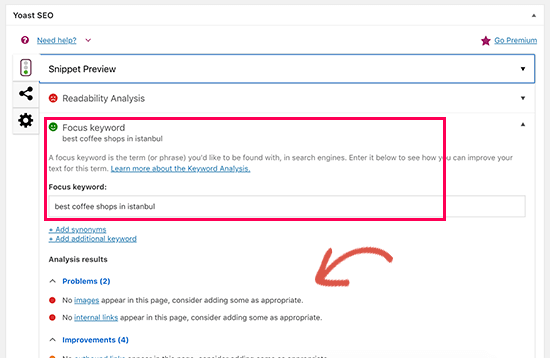
2. Outdated Information - Refresh your article: Over the years, months or days, some new articles targeting the same keyword like you might appear. It’s relatively easy to forget about your articles and leave them on the side. But if you want to boost their rankings, make sure to update them and provide newer and more accurate information inside.
For example, an article titled with “Best SEO Practices in 2015” definitely can’t beat the article “Best SEO practices in 2019”.
Thus - make sure to refresh your articles, update the content, add new examples and import the facts that are relevant right now.
3. Internal Linking: Internal linking is when you link an article from other pages of your site to your article. Linking to an article in other related content can give you a nice SEO boost. Here, you should use your target keyword as the anchor text when linking to it from other articles on your website. This helps Google to identify your other websites and perhaps give them a little boost in SEO rankings
The easiest way to do this is to import links from your other articles into the article that your writing right now.
You can also run a monthly roundup where you will go through all of your older articles and place links to your new ones.
4. Backlink Building: Backlink building is similar to internal linking. But this time, the other websites are giving backlinks to your website.
Unlike internal link building, backlink building has better SEO juice and can give you the bigger SEO boost.
As soon as some other, authoritative websites are linking back to your content, it gives a clear sight to Google that your content is great and useful. Soon afterwards, it may improve your SEO rankings.
There’re a lot of ways to do backlink building. Here’re just some of them:
a. Find broken links on other websites that are leading to articles or pages that are similar to yours. Reach out to blog managers of those websites and ask them to replace the broken link with yours.
b. Use HARO (help a reporter out) to get notified whenever some journalists and reporters are in need of some information. If you find something interesting to your content, they will be happy to give a link back to your site. With HARO, you can easily get featured and mentioned on Forbes, Entrepreneur, CNN, and other high-authority websites. Getting links from these sources will kickass your SEO rankings.
c. Write guest blog posts. Guest blog posts are a great way to put your links on other people’s website. Although it’s a little bit time-consuming - it’s definitely effective. Identify other relevant websites in your industry, find out who’s managing their blog, and reach out to them asking for a guest blog post. Suggest a couple of topics you could write, and you’re ready to go (if they accept you of course).
Or, you can use some scalable technic that won’t take too much of your time, and that will still bring you great results. Here’s how Aazar Ali Shad, Head of Growth at Userpilot - user onboarding software, is doing that:
“At Userpilot, we’re building different backlink partnerships with other companies in our industries. Since all of us are writing a lot of guest blog posts per month, we’re making sure that in our guest blog posts we’re linking back to each other. On this way, we’re able to get over 20 different links from high-authority domains.”
IT’S ALSO IMPORTANT TO KNOW WHAT YOUR WEBSITE VISITORS DOING ON YOUR WEBSITE
SEMRush and Google Search Console can help you find your keyword positions, but they can’t show you how many visitors are coming to your articles, where they are from, and what they do when they are on your website
Collecting all of this information is crucial when creating your SEO, Digital and Content marketing strategies.
That’s the reason why you also need to use Google Analytics. It shows you the number of website visitors you have, the pages they’re visiting, their flow through your website and much more.
You can also use exit-intent WordPress plugins to capture your website visitor’s email and nurture them through your sales funnel afterwards. It’s a great way of making sales from your keyword rankings and organic traffic. Remember that not all of your website readers will convert and pay you - so using exit-intent pop-ups is crucial to stay in touch with them after they leave your website.


About the author
Rachael Chapman
A Complete Gamer and a Tech Geek. Brings out all her thoughts and Love in Writing Techie Blogs.
Related Articles
Know how to Get into the Sneaker Game
Learn how to get that favourite collection of shoes you’ve wanted without having to wait for long queues. Know how to Get into the Sneaker Game
Ultimate Guide for Facebook proxies
While the social platform is great, it does have a few drawbacks such as restrictions. Here is an Ultimate Guide for Facebook proxies